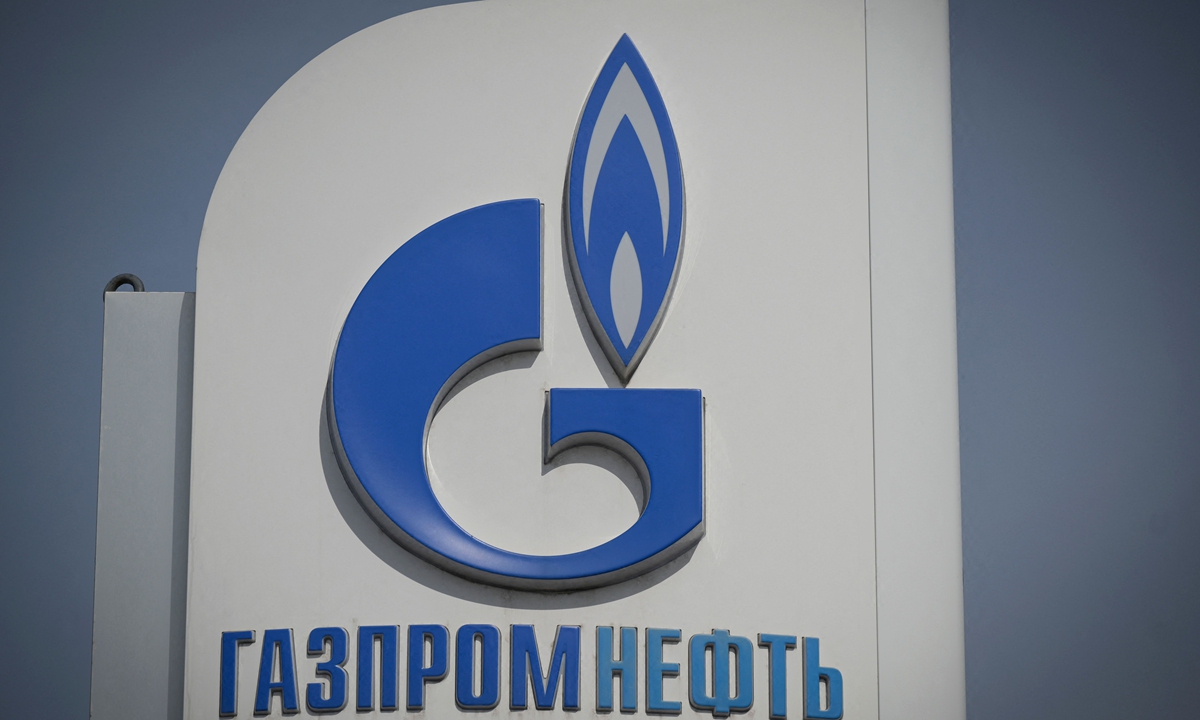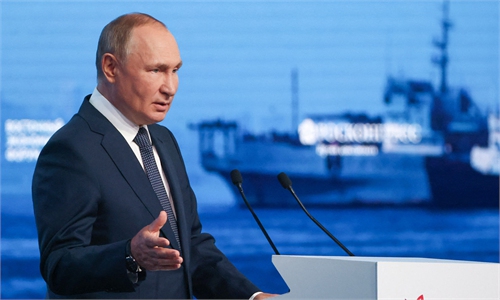Russia’s Gazprom to settle gas exports to China, using ruble, yuan, instead of dollar
Yuan, ruble to supplant dollar as gas settlement currency: Gazprom

The logo of Russia's energy giant Gazprom is pictured at one of its petrol stations in Moscow on May 11, 2022. Photo: VCG
China and Russia have moved to strengthen their energy and financial cooperation with the signing of an agreement on Russia's eastern natural gas pipeline to China, and a switch of the gas payment currencies from the US dollar to Chinese yuan and Russia ruble.
Russian President Vladimir Putin said on Wednesday that China would pay Gazprom for its gas based on a 50-50 split between the rouble and yuan, according to Sputnik News.
China National Petroleum Corp (CNPC), a state-owned energy giant, said on Wednesday in an online statement that it signed a deal with Russia's Gazprom - the Sino-Russian Eastern Route Natural Gas Purchase and Sale Agreement - via a virtual meeting during the Eastern Economic Forum (EEF) being held in Russia.
The two sides exchanged views on extensive cooperation in the field of natural gas, the statement said.
Gazprom announced on Tuesday that it had signed an agreement to start switching payments for gas supplies to China to the yuan and the ruble, instead of the US dollar, Reuters reported.
"Pursuant to the new documents, inter alia, settlements for Russian gas supplies to China will now be made in the national currencies of the two countries, i.e. the ruble and the yuan," read a statement on the website of Gazprom.
Gazprom CEO Alexei Miller said that the new payment mechanism is a "mutually beneficial, timely, reliable and practical decision" and will "make settlements easier, serve as a great example to other companies, and give a new impetus to our economies," according to the statement.
Gazprom did not provide further details or say when the new arrangement will start.
The Sino-Russian Eastern Route is also known as the Power of Siberia pipeline. It began shipping natural gas to China in 2019. When the project reaches full capacity the volume of Russian pipeline gas supplies to China will reach 48 billion cubic meters per year, according to Gazprom.
The latest agreement is of great significance for China and Russia, Hong Tao, a professor with the Beijing Technology and Business University, told the Global Times on Wednesday.
"It will allow China to secure a large amount of natural gas every year, which is of great significance to meet market demand. Meanwhile, China provides Russia with a stable market, which is of great strategic significance amid the ongoing conflict between Russia and Ukraine," Hong said.
In particular, switching to the yuan and the ruble to settle gas trade could help Russia reduce its reliance on the dollar amid US economic sanctions against its banking system, while help reduce cost of trade between the two countries, Lin Boqiang, director of the China Center for Energy Economics Research at Xiamen University, told the Global Times on Wednesday.
"How the price will be set and linked to international market energy prices, will require further negotiations," Lin said.
In the latest development for the eastern gas route, Gazprom said that the construction of the linear part of the gas pipeline -- stretching from the Kovyktinskoye field in the Irkutsk Region to the Chayandinskoye field in Yakutia -- is almost 100 per cent completed. As planned, Power of Siberia will start receiving gas from Kovyktinskoye before the end of this year. This will allow Gazprom to fulfill its contractual obligations on increasing gas exports to China in 2023.
Particular attention at the meeting was paid to the Power of Siberia 2 gas pipeline in Russia and the Soyuz Vostok gas pipeline in Mongolia, which will link Russian and Chinese gas transmission systems, Gazprom said.
Lin said that closer energy cooperation between China and Russia is likely to maintain the momentum due to their high complementarity in energy structure.
"Russia possesses huge energy reserves, and energy exports hold an important position in its economic development, meanwhile China offers a giant market for Russian energy," Lin said.
Exploring China-Russia currency swaps and expanding the scale of national currency settlement will protect bilateral trade and investment from the volatility of exchange rate risks inherent in using a third currency, such as the dollar, and boost bilateral economic and trade exchanges, Liang Haiming, dean of the Belt and Road Institute at Hainan University, told the Global Times on Wednesday.
Bilateral trade between China and Russia increased to $117.2 billion from January to August this year, surging 31.4 percent year-on-year. China's imports from Russia came in at $72.95 billion, up 50.7 percent, according to data from China's General Administration of Customs (GACC) released on Wednesday.
China's demand for oil and gas and Russia's demand for manufactured products are highly complementary, and the situation provides a good condition for the two sides to explore settlement in their own currencies, Wang Xingping, a research fellow with Nanjing University, told the Global Times on Wednesday.
Andrey Kostin, the head of Russia's second-largest bank VTB on Monday, said that Russian banks should increasingly favor currencies like the ruble or the yuan over other currencies when carrying out cross-border trade, Reuters reported.


